

Stanford psychology expert: The No. 1 work skill of the future. It’s 9 a.m.: You walk into the office, sit down, fire up your computer and attempt to start your workday.

Ping! Everyone is talking about Trump’s latest tweet. Ping! There it goes again — a family member just texted you. You pick up your phone to look at the news notification and answer your text, only to check a Facebook post and then watch a Youtube video. A lack of focus comes at a cost. How To Stop Checking Your Phone: 4 Secrets From Research.
Before we commence with the festivities, I wanted to thank everyone for helping my first book become a Wall Street Journal bestseller.
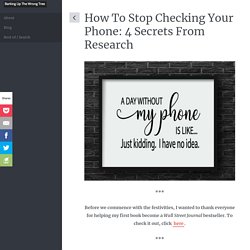
To check it out, click here. If I told you we check our phones 5 billion times a minute you’d probably just shrug and agree. Why Phone Conversations Are Better Than Texting. Nevertheless, I’m here today to confess my sins and ask forgiveness from all those whose voicemails I have not listened to.
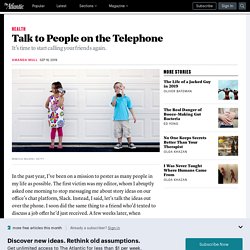
To fully repent, I must make clear what I now know to be the truth: Phone calls are good, actually. One of the best arguments in favor of phone calls will be obvious to anyone who’s ever gone back and forth for three days via email trying to pick a spot for Tuesday’s happy hour. Guhan Subramanian, the director of the Harvard Program on Negotiation, which teaches business- and law-school students the finer points of conflict resolution, argues that spoken conversation accomplishes far more in a shorter amount of time. In any discussion, “people are asking questions, probing, asking follow-up questions,” he says. “It’s obviously a lot easier to do when you’re over the phone or in person, compared to by email or text.” This difference is what first pushed me back to phone calls. Are we losing the art of telephone conversation? Statistics illustrating our addiction to our smartphones come out quite frequently and receive a lot of attention for information so unsurprising; it will come as no shock to anyone that the average Briton checks her phone every 12 minutes.
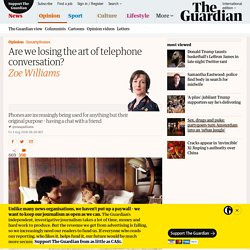
Indeed, I’d like to pick a fight with the blandness of the questions asked in Ofcom’s latest telecommunications report. I wish they’d included: “Have you ever picked up your phone to Google where your phone is?” Or: “Have you ever smashed or otherwise been suddenly deprived of your phone, and wanted to stand in the street howling like a wolf?” The report belongs in the news category “things we already knew, but are worried about, so will continue to pick at like a scab”.
Formula for success in learning. If you have found this place in the vast cyberspace of the web, you are probably not the one to convince that knowledge is power, and that solutions to most problems facing humanity could be found if we were armed with more understanding of how the world works.
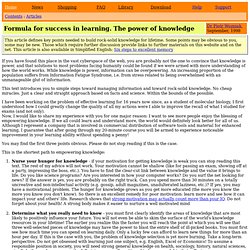
While knowledge is power, information can be overpowering. An increasing proportion of the population suffers from Information Fatigue Syndrome, i.e. from stress related to being overwhelmed with an unmanageable glut of information. This text introduces you to simple steps toward managing information and toward rock-solid knowledge. No cheap miracles. Just a clear and straight approach based on facts and science. Education - Challenge Based Learning.
Evaluating multimedia presentations. Learn fast and forget about forgetting. Students don't pursue STEM because it's too hard, say 52% of Americans. When Americans are asked why more students don’t pursue a degree in science, technology, engineering or math (STEM), they are most likely to point to the difficulty of these subjects, according to a new Pew Research Center survey.
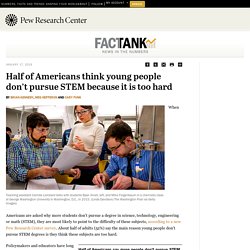
About half of adults (52%) say the main reason young people don’t pursue STEM degrees is they think these subjects are too hard. Policymakers and educators have long puzzled over why more students do not pursue STEM majors in college, even though those who have an undergraduate degree in a STEM field of study earn more than those with other college majors – regardless of whether they work in a STEM job or a different occupation. Yet only a third of workers (33%) ages 25 and older with at least a bachelor’s degree have an undergraduate degree in a STEM field, according to a new Pew Research Center analysis. Teaching the Research Process Through Podcasting Instead of an Essay. I have to be honest: I’ve often dreaded teaching research papers in my high school English classes.
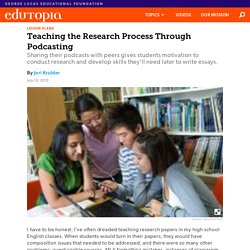
When students would turn in their papers, they would have composition issues that needed to be addressed, and there were so many other problems: questionable sources, MLA formatting mistakes, instances of plagiarism. Often I wouldn’t even know where to start assessing this work, even though these are all skills I consider essential in my classroom. Eventually I came to realize that they didn’t all have to be taught at the same time. I also needed to find ways to help motivate my students to take ownership of their research process because the biggest problem with the papers was their incredible blandness.
Without proper guidance, students miss the point of research: to look into a question and develop new questions, insights, and ideas as they search. Choosing and Narrowing Topics. 26 things a technical editor will tell you – David Barnes. The Weird Strategy Dr. Seuss Used to Create His Greatest Work (And Why You Should Use It Too) In 1960, two men made a bet.
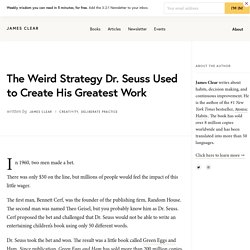
There was only $50 on the line, but millions of people would feel the impact of this little wager. The first man, Bennett Cerf, was the founder of the publishing firm, Random House. The second man was named Theo Geisel, but you probably know him as Dr. Phylogeny Programs. Here are 392 phylogeny packages and 54 free web servers, (almost) all that I know about. It is an attempt to be completely comprehensive.
I have not made any attempt to exclude programs that do not meet some standard of quality or importance. Updates to these pages are made roughly monthly. Here is a "waiting list" of new programs waiting to have their full entries constructed. Many of the programs in these pages are available on the web, and some of the older ones are also available from ftp server machines. The programs listed below include both free and non-free ones; in some cases I do not know whether a program is free. Email addresses in these pages have had the @ symbol replaced by (at) and also surrounded by invisible confusing tags and blank characters in hopes of foiling spambots that harvest email addresses. ... by methods available ... by computer systems on which they work ... cross-referenced by method and by computer system.
Digitalportfolio - What is a digital portfolio? How-to (GoogleSites) - ePortfolios with GoogleApps. Developed by Helen C.
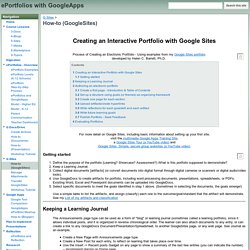
Student Learner Reflection Portfolios Examples. Students ePortfolios Digital Storytelling for Teachers INTEF on Pinte… Organize your resources in an online digital binder - LiveBinders. ePortfolio Project. Housed in the Office of University Writing, the ePortfolio Project is a campus-wide initiative that offers Auburn students the opportunity to create personal websites that: Communicate and showcase skills, experiences, and learningContain diverse artifacts—documents and mediaContextualize those artifacts for potential employers, graduate schools, etc.

ePortfolio Review. Please add and review the eportfolio system you use at your school, college or university. Below is a list of the eportfolios we are reviewing along with others we felt were worth noting. Please comment on the eportfolio platforms and make suggestions for others we should review. Please indicate which eportfolio category (categories) best suit the eportfolio platform you are reviewing…Showcase, Learning, Career and Course/Program Assessment. eLearning Best Practice: Curate Instead Of Create Content. Design 101: How to Make Great Graphics Without Design Skills. Intimidated by design? You’re not alone. Writing and coding is difficult enough on its own; visual content can feel like new (and, honestly, overwhelming) territory.
But fear not: You don't need an art degree or thousands of hours logged in the Adobe suite to build engaging designs. With the right resources and a clear plan, anyone can put together compelling art for a blog post, Tweet, website, app, or other project. That means instead of asking your designer or hiring a freelancer to develop basic images, you can make them yourself. Visual Complexity.
How to tell if you’re being ‘breadcrumbed’ at work - BBC Worklife. Allusory. Breathe for Life. Busyness Modelling. Computeresque. Data Bowl. Engineerable Feats. Health Activities. Multiple Intelligences. Netwise. Peopled Experiences. Planted Projects. Robotzone. AIyaiYAIyiyAI. Time Well Spent.